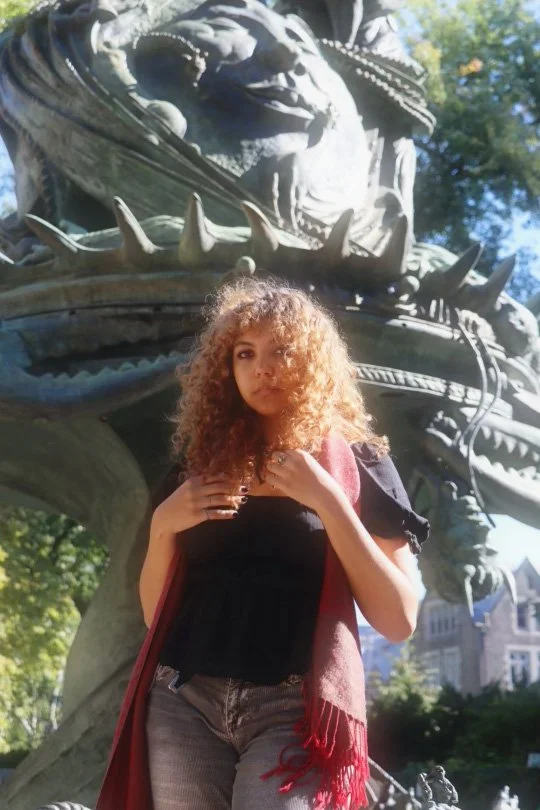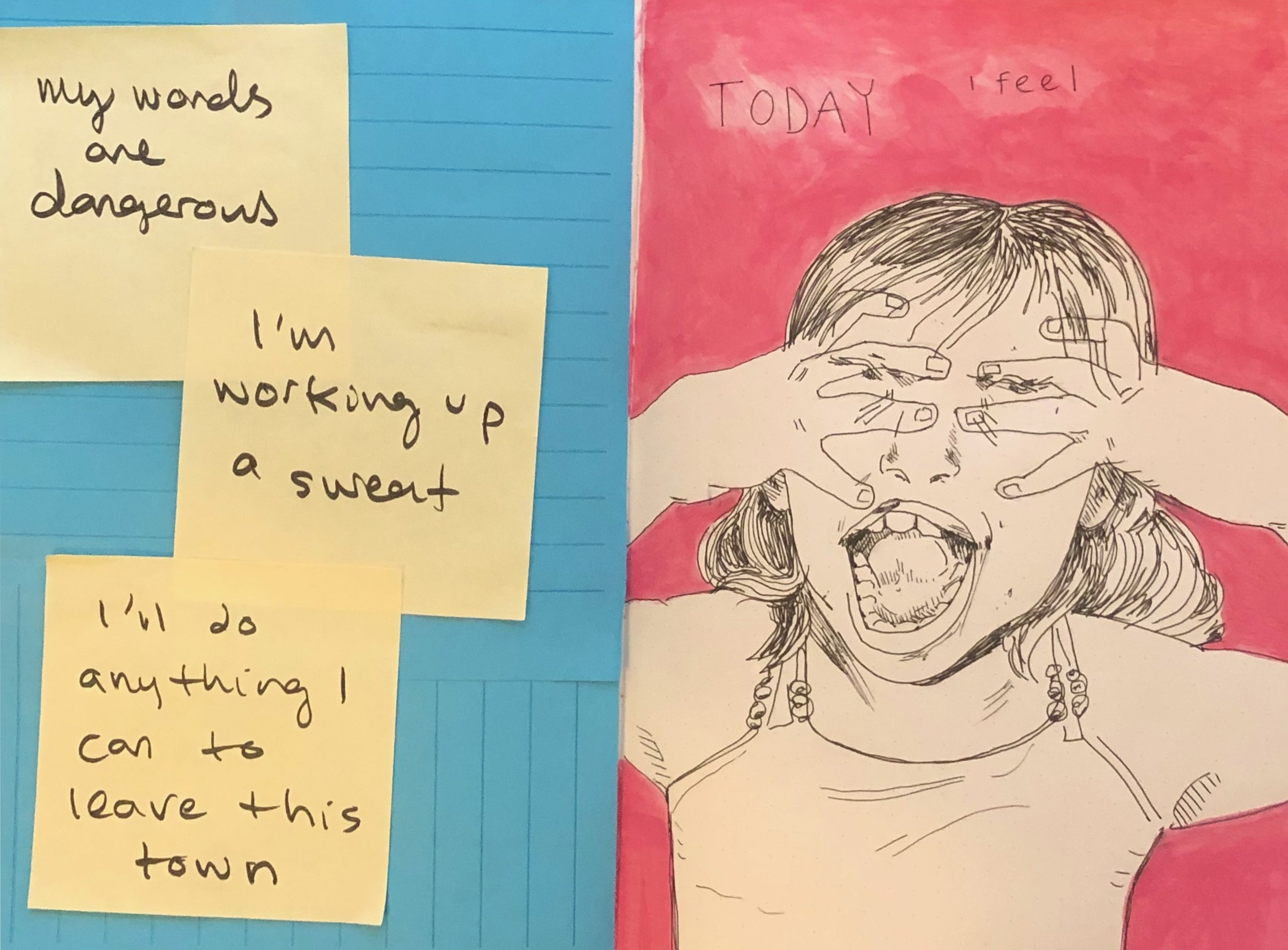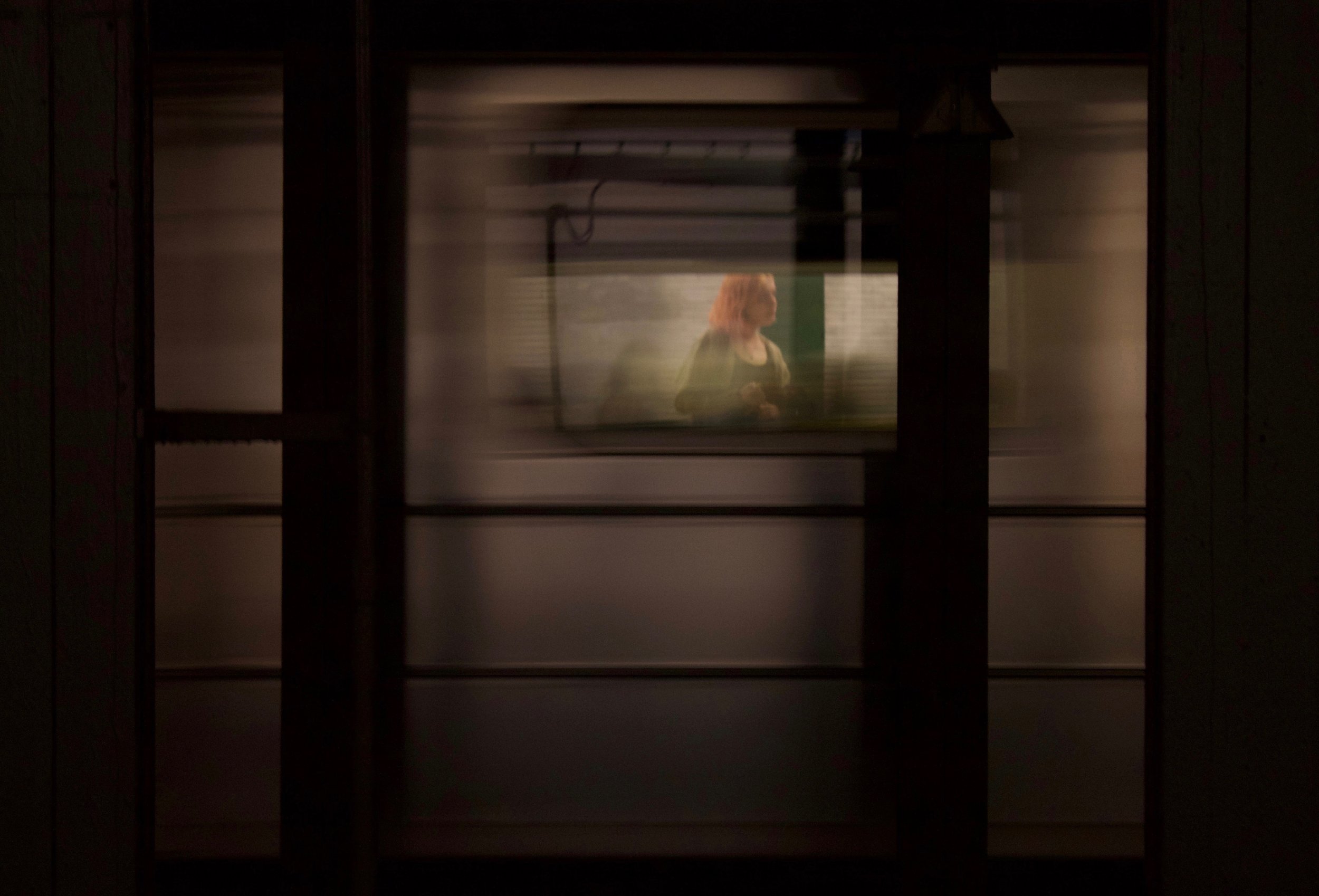
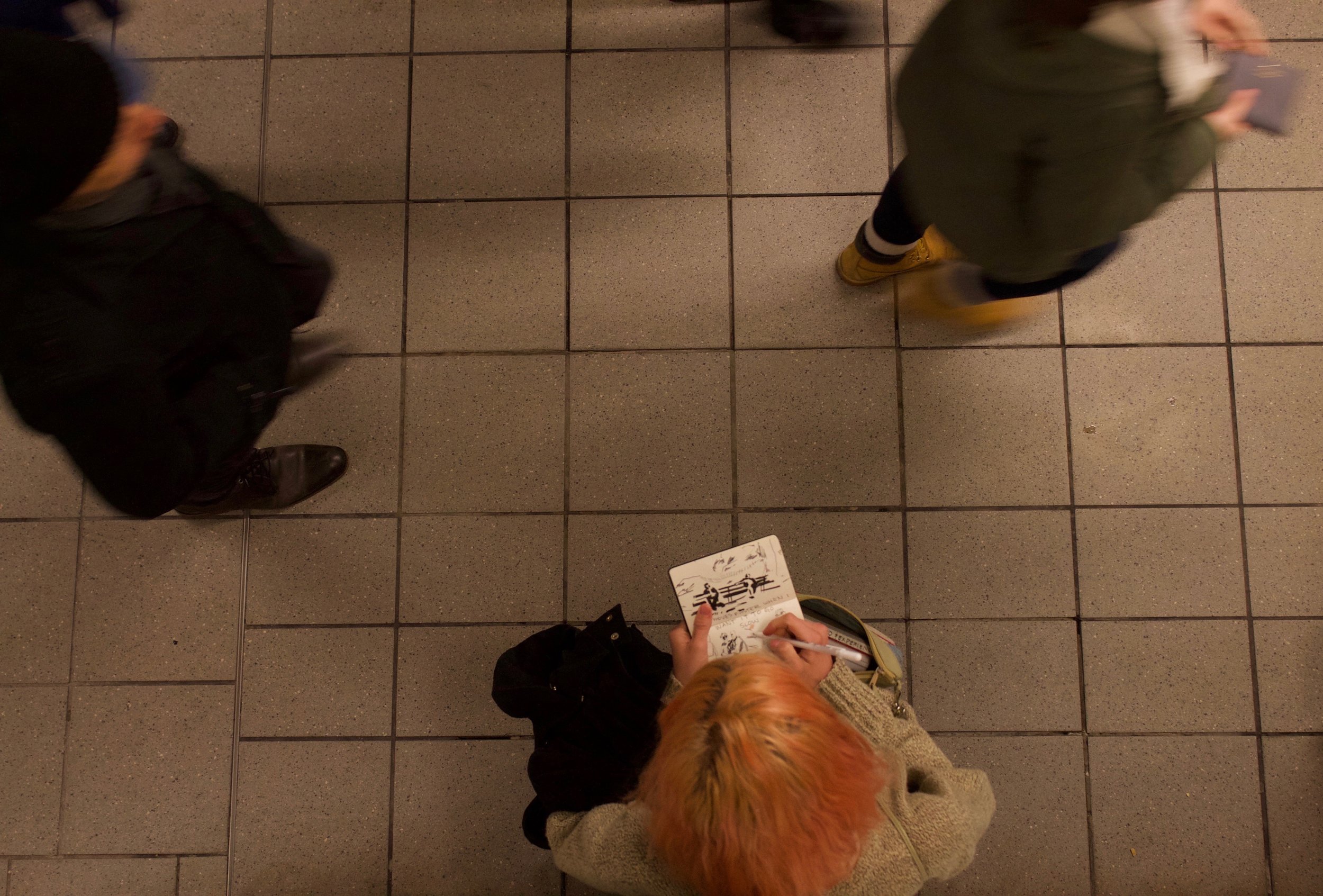
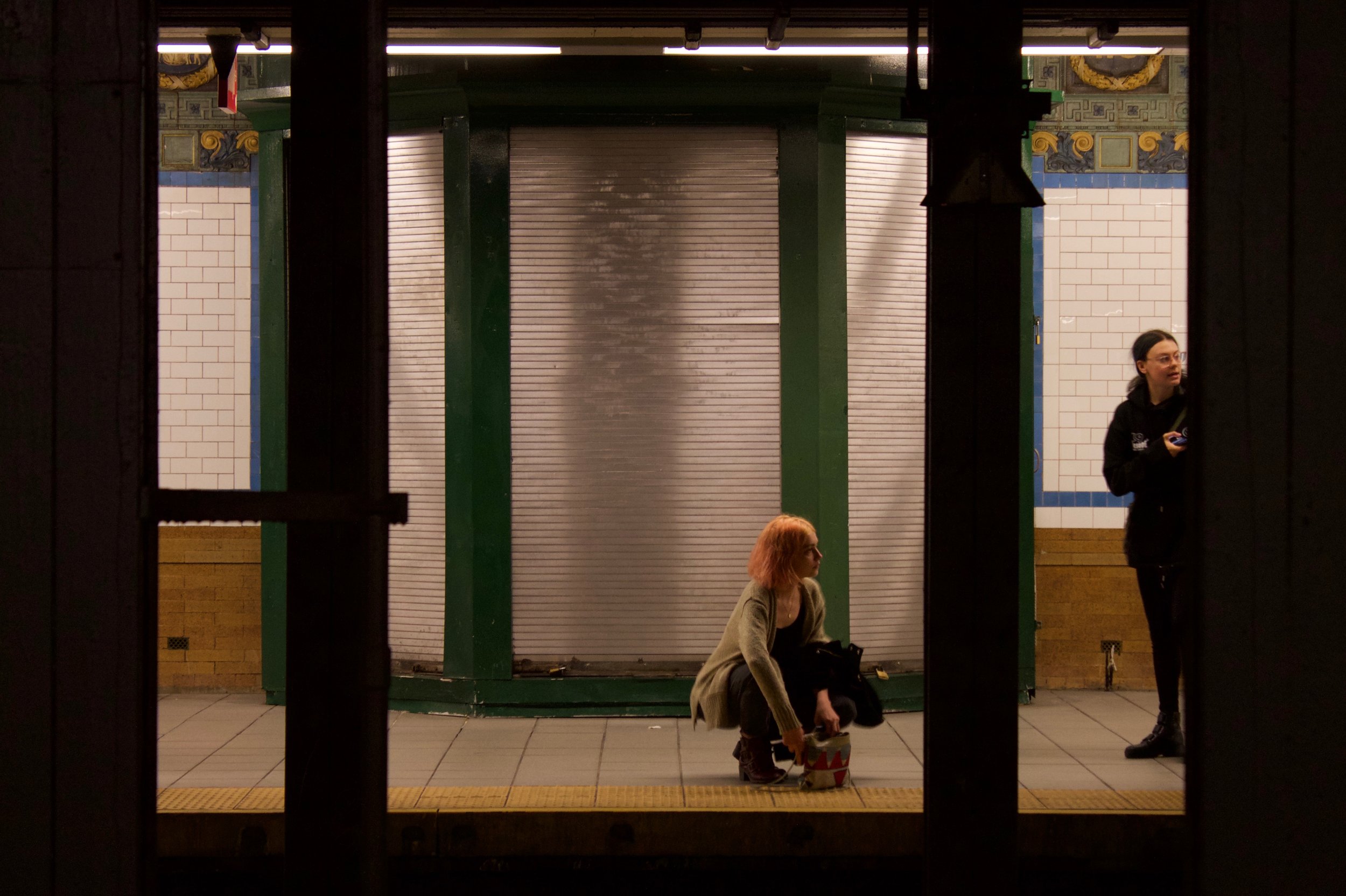
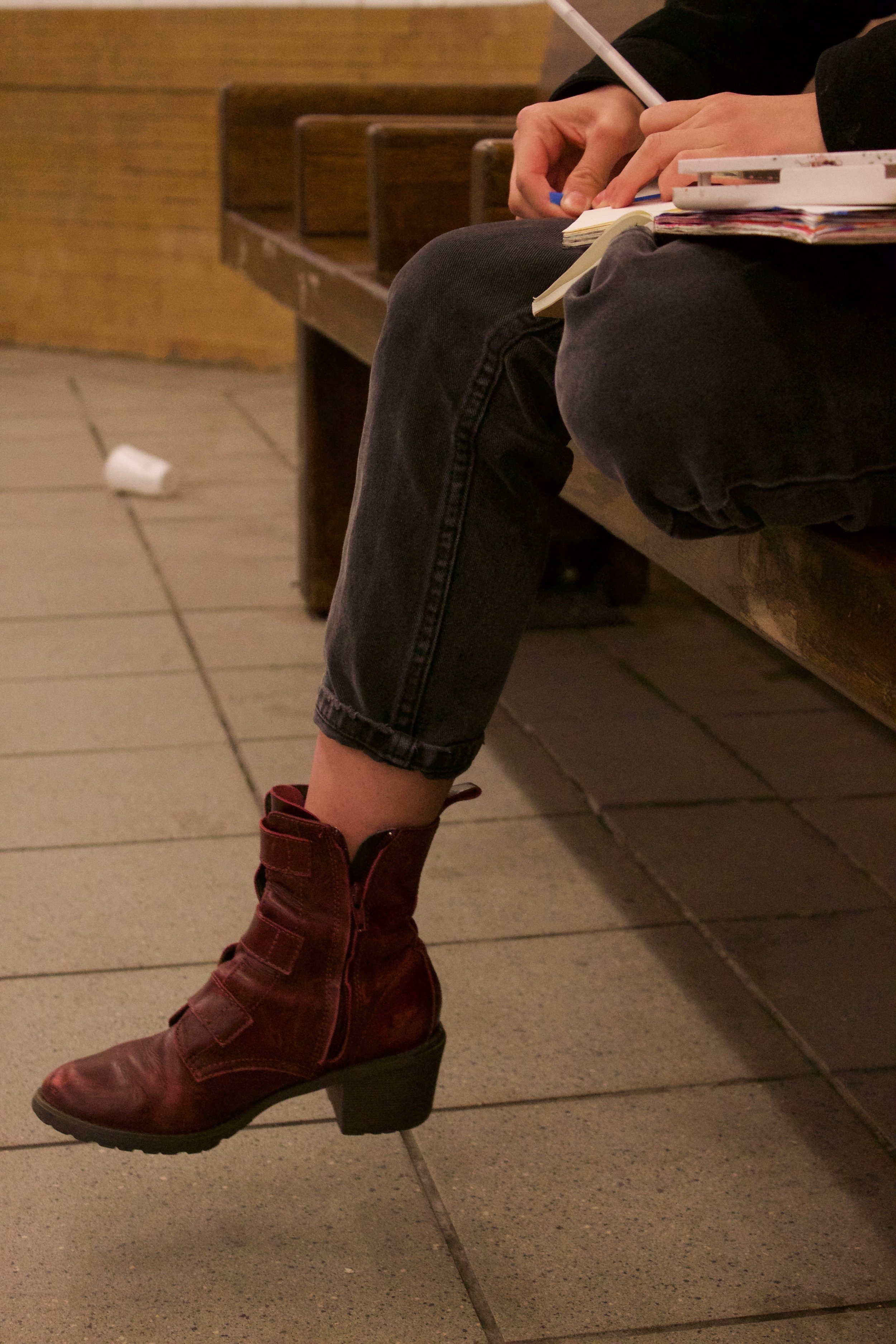
Photographs by Emily Sures
Interview by Louise Sandback
Tuesday Smith is a sophomore at Barnard College from Seattle, Washington, studying Chemistry and Art History. In addition to her own art practice of drawing and painting, Tuesday is interested in art conservation and works as a scientific research assistant at the Metropolitan Museum of Art.
What has been your experience with art conservation thus far?
I’m working at the Met this year as a scientific research assistant in their conservation lab. We have been working with polyurethane samples from American fabrics collections from the nineteen sixties to eighties. So anything that’s a plasticy fabric—faux leather, for example. Since polyurethane is relatively new (compared to a lot of other materials) in the collection, they’ve only recently started to degrade and no one knows how to prevent that. So I’m working with those and figuring out how we might conserve them.
Has the opportunity to do that, and your work in art conservation, informed your artwork at all?
It hasn’t so much yet. I’ve found myself incorporating geometric shapes and doing more drawings of things reflecting because I have to do that for chemistry. I’ve gotten more interested in using those kinds of ideas in my art, but I haven’t had much time to make art recently. I’m hoping to make my own paint this summer. I love oil paints but I’m hesitant of the cost and time commitment, so I think making my own would be really fun and would motivate me to actually use the paints because it’s easy to just leave paints in the corner and not break them out and annoy your roommate.
Do you identify as an artist? If so, when did you first begin to?
I’ve been thinking about this a lot, because I don’t know if I ever really thought of myself as an artist. I always thought of myself as being artistic but artist felt too professional, and like I had to do that for a living. I also just didn’t feel intentioned enough because artmaking is kind of more spontaneous for me and I kind of doing it just to process things happening around me. So I never really felt like an artist even though that’s what an artist is. I didn’t think of myself as one until I stopped drawing last year which made me realize that making art is a huge part of my identity.
What has been your process of self-teaching?
When I was really little I was obsessed with drawing books like ‘How to draw cats in three steps.’ I’d just be like ‘okay!’ and I’d just practice that and draw the same thing over, and over, and over again. It was all about realism when I was younger. So I eventually got good at that. Then I got really into cartoons, so I started copying from graphic novels like “Coraline” and, “Smile” by Raina Telgemeier. As a kid I just made copies of work by other artists. That’s kind of where I got started drawing and ever since then I haven’t really stopped.
What purpose does your artwork serve for you personally?
I think since coming to college most of my art has been tied to journaling, so it’s all very personal. It’s like self-therapy. When you journal with writing it makes you think about different things in your life and realize what’s bothering you and what’s making you feel off at certain times. So that’s kind of what art does for me. A lot of my art I can’t share because it’s just, like, personal ramblings. It also helps me because chemistry can be very analytical, and I’m now taking a lot of quantitative classes which is not how my brain works usually. So it makes me loosen up a little bit and feel like myself again.
Can you describe your artistic process?
I didn’t know how I’d describe this, so I got my friends to give me some words: spontaneous and melty were two. I’m also methodical once I get started because I get kind of consumed by [my art]. It takes me awhile to get started, but once I do everything falls into place. I like melty because I don’t use erasers and work in pen so every mistake gets incorporated. That’s why I make so many distorted faces. It’s part style part laziness.
What would you say is your main medium?
I use brush pens the most. I’ve been using paper more—just collaging a little bit. My favorite mediums are probably pastels or drypoint etchings—I really like drypoint etchings, but I don’t have the materials for that. I want to get more into printmaking more.
What do you find yourself representing the most?
I think I usually represent people and bodies. In high school I did a lot with public transportation and how people relate in public spaces. Thinking about times when you’re alone but [are] still around other people, and how that changes how you position yourself in space. I’ve always thought [a lot] about touch without touching.
Do you do your preliminary sketches while you’re on public transportation?
I still do that sometimes because I think it’s fun, but I think it’s a little more obvious when you’re sketching people on the subways so it can get weird fast. So I take a lot of photos—not of people, but of angles and objects. I have a lot of photos in my phone that I like to go back to and mush together.
I like drawing in parks too. If you go to those rocks in Central Park, those big ones you can sit down on, I like drawing from there a lot.
Do you ever think of yourself and how you relate in those spaces?
I think about it a little bit. I like watching how other people interact more, especially in a city like New York where so many people are packed into such a small place. I mostly think about how other people are interacting. When I draw in public I think more about who I am inside and how that differs from the person I am presenting.
How would you describe your artistic practice in one sentence?
I feel like ‘spacey with a purpose’ is pretty good. I don’t really know how to describe my art because it varies so much. That’s something I’m insecure about in my art—just that I’m all over the place and I don’t really have a set style or a set medium because I’m just making it for whatever I have going on in my life right then and with whatever materials I have. I don’t really feel that it’s very focused ever, so it’s kind of hard to describe in a sentence.
What’s one work that you’re particularly proud of or particularly enjoyed the process of making?
I made a piece called “Green Arrow” during my junior year of high school. It focused on public transportation, and it’s of some people getting onto a bus and paying their fares and then starting to walk back. It was such an exciting piece for me because I just got really in the zone when making it; I was listening to new music, and I was using a new medium—well it was color pencil, so it wasn’t a new medium, but it was on black paper. I didn’t really do a preliminary sketch for it, which is something I don’t do anymore at all, but I used to do it a lot back then. That was also the first time I stopped making myself do preliminary sketches and just let myself go. I entered the piece into the Congressional Art Competition ended up going to DC as the winner for my district in Seattle. So it was a big turning point for my art in so many ways.
Have you been involved in the Columbia arts community at all?
Not really. I feel like I haven’t been involved in it at all which is kind of why I wanted to apply to Ratrock. I like going to galleries and museums in my free time, so I feel like I’m more involved with the art scene outside of Columbia.
That’s actually what I hear from a lot of people. Would you say that your being a STEM major has contributed to this?
Yeah, it’s kind of heartbreaking. I feel like—as you said, a lot of [STEM majors] have that same struggle, but there’s not really a way to connect people unless you go out of your way to try to get involved. I have my art account on instagram, and I posted on my story one day that I want to talk to other people who are STEM majors and doing art. I got so many responses from STEM majors [who] felt isolated in a similar way from this part of their identity, and it made me more committed to finding a better way to find a balance between the two and a support system for people who are confused about where they stand between them.
Art and science are not mutually exclusive and even at a liberal arts college I feel like they’re treated as such. I think you suffer if you neglect either side of that divide and I’m really interested in talking to more people about this and organizing ways to allow for better interaction between different disciplines here.
Are there any other significant sources of inspiration for you?
Yes, Alice Neel. I really like how she represents people in their interactions with each other because it’s like that distance but closeness at the same time. So they’re both so distorted that they could kind of be in their own world, and I really enjoy that about it, and it’s something that I like to represent in my own work too.
Have you done any other design/illustration work?
[I made] a few little things [for] a gallery I interned at in Seattle over the summer. Other than that, illustrating for newspapers—like my high school newspaper and ones here. I designed a couple tattoos. That was fun. I did one for my mom’s friend but don’t know if they ever used it, and then small things for other friends.
You do tattoos? Just having looked at your art—they would make sick tattoos.
You want a tattoo?
I would literally commission a tattoo.
I would love to do more tattoos. That could be really fun.
I feel like you could have a real audience for that here. It would be a good dorm hustle.
Yeah. I could dye hair, learn to do stick-and-pokes. My parents are going to love this.
If you could only artistically represent one subject for the rest of your life what would it be?
I think it would be touch. I feel like that’s broad enough that I wouldn’t get bored. Because that could be—I don’t know... I feel like [for] a lot of [humans] navigating public transportation is [about] trying not to touch, or moments before touch, or rebounding when you’re forced into it. I think that art that overlays images of movement is really interesting, like Jenny Saville. She’s like a big inspiration, and her’s are all about motherhood, femininity, bodies, and gender and a lot of things about touch and relationships. I think that’s something that I really enjoy representing and I enjoy looking at. Just people. And distortion.





























